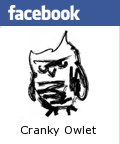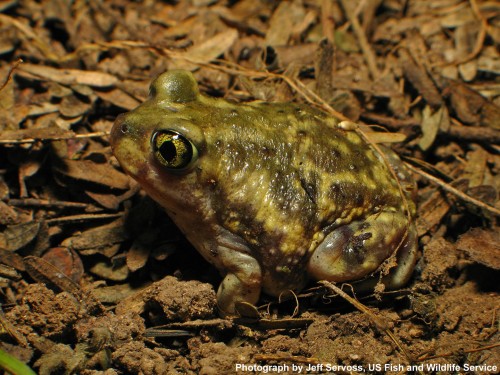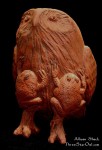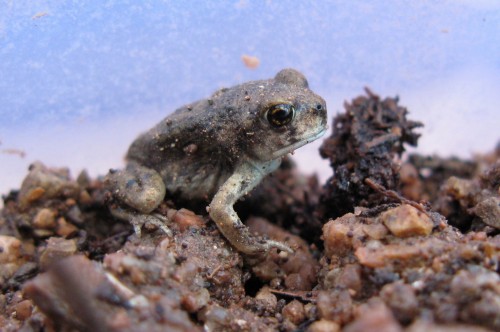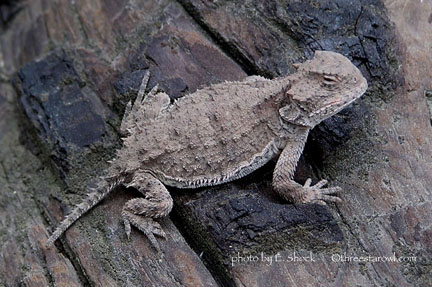Last night at 3.00am exactly, I heard the Great horned owl call. Very close, somewhere right in the back yard. The windows were open because a light monsoon event had brought fresh rain-cooled air, so the call, though soft, carried clearly.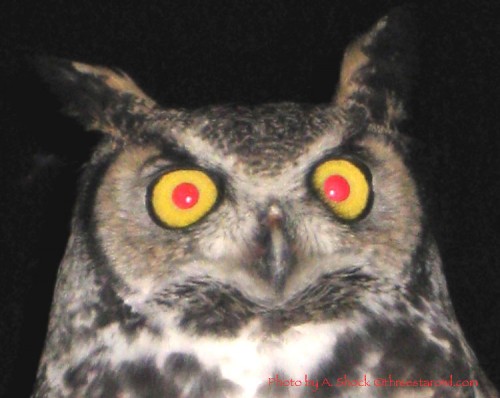
Great horned owls are regulars in our area because there are plenty of perches, and plenty for them to eat. A favorite owly destination is a big Aleppo pine in our back yard. At night that tree is stuffed with roosting doves and other perching birds, a veritable Fresh and Easy for owls. Sitting outside at dark with friends, we’ve watched a horned owl glide stealthily into mid-level branches and then listened as panic ensued among the roosting doves as the owl hopped between branches as if it were going aisle to aisle in a grocery store, filling a cart. Finally it burst out of the needles with a meal clutched in its talons. We got a good look at it is it slid past us, sihouetted against the lights of the house. The feather pool under the pine the next morning was evidence that it had enjoyed a bit of mourning dove.
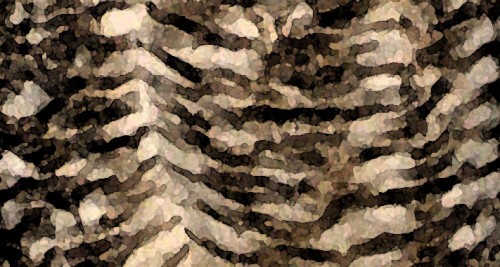 They are not called “Flying tigers” for nothing. Horned owls, like toadlets, will eat anything that moves and fits down the gullet. Rock squirrels, snakes, desert cottontails, other birds (even other owls), insects, and bats — all are fair game. Even small pets may be at risk, if left unsupervised after dark. The first owl I ever saw was at the family dinner table when I was a kid: a thump, a commotion, and we looked up to see the underside of a Great horned owl pressed to the window, wings flapping against the glass. The owl was trying to separate the family cat (a calico named Ringo, to give you an idea how long ago this was) from the window ledge. A grown cat is awfully heavy prey, however, and the owl had to give up after a few seconds. No one was hurt, but the bird went away hungry. (It was a spectacular view of an owl in action, and I’ve wondered if that was THE bird for me, in a formative sense — I was no more than seven). The boldest hunters are often adults with young to feed — a nest full of hungry owlets requires a lot of sustenance. During that time of the year, parent owls sometimes can be seen hunting even during daylight, working a day job to put food on the table. So, hatching and fledging are timed to coincide with the local peak of yearly rodent production, usually spring, but in the desert areas often much earlier.
They are not called “Flying tigers” for nothing. Horned owls, like toadlets, will eat anything that moves and fits down the gullet. Rock squirrels, snakes, desert cottontails, other birds (even other owls), insects, and bats — all are fair game. Even small pets may be at risk, if left unsupervised after dark. The first owl I ever saw was at the family dinner table when I was a kid: a thump, a commotion, and we looked up to see the underside of a Great horned owl pressed to the window, wings flapping against the glass. The owl was trying to separate the family cat (a calico named Ringo, to give you an idea how long ago this was) from the window ledge. A grown cat is awfully heavy prey, however, and the owl had to give up after a few seconds. No one was hurt, but the bird went away hungry. (It was a spectacular view of an owl in action, and I’ve wondered if that was THE bird for me, in a formative sense — I was no more than seven). The boldest hunters are often adults with young to feed — a nest full of hungry owlets requires a lot of sustenance. During that time of the year, parent owls sometimes can be seen hunting even during daylight, working a day job to put food on the table. So, hatching and fledging are timed to coincide with the local peak of yearly rodent production, usually spring, but in the desert areas often much earlier.
Our local owls have reproduced, and sometimes I’ve heard the distinctive, raspy oink of a horned owlet begging,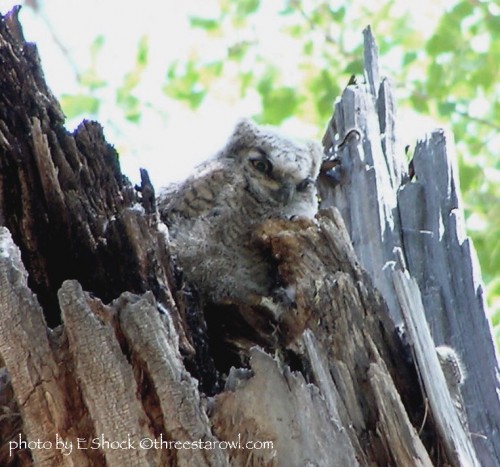 installed on the top of a phone pole while its parents search the alleys for rats or young cottontails to stuff into it. (If you enjoy camping, you’ve heard a sound like it: the creak made by the plastic hinge on a cooler lid when it’s raised.) The female makes the same sound during courtship while soliciting her mate for food. In our area, courting owls can be seen and heard duetting on phone poles and rooftops, visible against the fading sunset sky. As they call together or alternately — the male and female have slightly different voices and cadences — they bow and “hoo.” She holds her tail up, soliciting attention from the male, who strikes a courtly pose to “sing,” tail raised and wings down, maximizing himself like an operatic baritone (he’s smaller than her). Here’s an excellent quote, where the author’s voice slides from ornithologist to owl, almost inadvertently:
installed on the top of a phone pole while its parents search the alleys for rats or young cottontails to stuff into it. (If you enjoy camping, you’ve heard a sound like it: the creak made by the plastic hinge on a cooler lid when it’s raised.) The female makes the same sound during courtship while soliciting her mate for food. In our area, courting owls can be seen and heard duetting on phone poles and rooftops, visible against the fading sunset sky. As they call together or alternately — the male and female have slightly different voices and cadences — they bow and “hoo.” She holds her tail up, soliciting attention from the male, who strikes a courtly pose to “sing,” tail raised and wings down, maximizing himself like an operatic baritone (he’s smaller than her). Here’s an excellent quote, where the author’s voice slides from ornithologist to owl, almost inadvertently:
“Courtship is fairly boisterous and involves bowing, bobbing, posturing, vocalizing, and allopreening. These elaborate activities lead, as one might hope, to copulation.” (from Hans Peeters, Field Guide to Owls of California and the West, my current favorite owl sourcebook. In the same series as the excellent book on Horned lizards, the California Natural History Guides, published by the UC Press)
If it’s still light enough while all this is going on, you can see flashes of white feathers at their throats, the “gular patch”, flashing as each hoot puffs the owl’s throat briefly. It’s a semaphore for them, like the feather tufts on the top of the head: a way of producing meaningful signals to each other: facial expressions without flexible tissue like lips or eyebrows.
As big, powerful generalist predators, Great horned owls can make it almost anywhere. Their range is right across the US and Canada through Central America and into northern South America. They live in urban, rural, and wilderness areas: desert, woodlands, mountains, wetlands, grasslands and cities, so the chances are you have them where you live, too. Keep an eye open, an ear cocked, and the Chihuahua in at night.
Below are Horned owl salt and pepper shakers from Three Star Owl. Each pair is an adult with an owlet in different stages of development ($48/pair).


